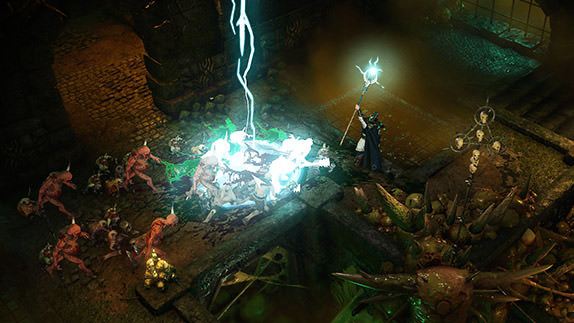The Evil Within 2 Review

 By Kevin Mitchell
Posted on October 17, 2017
By Kevin Mitchell
Posted on October 17, 2017
A parent’s love knows no bounds, and when former detective Sebastian Castellanos founds out his daughter Lily is alive, he heads back into a world of nightmares. Developer Tango Gameworks has altered the formula with The Evil Within 2, borrowing design elements from other titles, adding a semi-open world, but keeping the intense, terrifying corridor sequences from the first game. Picking up a few years after the incident at Beacon Mental Hospital, Sebastian willingly journeys into an improved STEM system; an alternate reality turned living nightmare by the mysterious organization Mobius.
With his goal of finding and taking his daughter away from the ordeal, Sebastian must also locate the operatives trapped in the town of Union, if any of them are still intact. Your first foray into Union leads you straight into the handiwork of a self-proclaimed artist and resident psychopath. From there, the game heavily uses its patented psychology horror elements, guiding you through winding corridors, complete with the occasional jump scares and tense musical score. Upon opening up the hub-like streets of Union, you’ll always know where you should be heading to advance the narrative, however, what you do before you reach that point is entirely in your hands. After finding out some valuable insight into what is happening inside the virtual environment from the first survivor you come across, Sebastian must fight his way through mutant infested streets. While still having chapters (for a narrative purpose), the game’s open-world design helps the game flow much better than it did in the first game, letting you take things at your own pace, especially considering the amount of items, upgrades and things you can do outside of the main narrative.
If you were to only focus on advancing the main narrative, you'd be missing plenty of lore and details that help bring the world to life. Not to mention, it can be quite lucrative to explore other houses and locations for crafting items, new weapons and anything else you can find. The game world is designed using stitched together large, explorable areas, with each one having plenty of points of interests. The open regions serve as a hub system, allowing you to meander your way to the next interior location. Outside of searching for useful supplies, considering the scarcity of ammunition on the higher difficulties, you’ll come across side-missions that are well worth the detour. These provide some insight into the missing Mobius team and exploring the maze of corridors behind the scenes of the town, nicknamed the Marrow.
The Marrow's relatively clean laboratory type corridors and cement walls are in stark contrast to the suburban Anytown USA feel to Union. As you progress through the narrative, the town breaks apart, large sections break apart, floating upside down and sideways in the sky. Bodies and body parts litter the streets, with puddles of blood almost covering every surface and vehicle.
Stealth plays a significant factor in the game, especially early on when your arsenal is somewhat limited. You can stay hidden in tall bushes, using your knife or ax for a quick kill, or distract enemies by setting off car alarms. My favorite tactic is using the smoke bolt, blinding foes in the process, letting you perform one-hit kills.
There are numerous moments in the game that reference the first title, but if you’ve never played it, you shouldn't feel discouraged. There are a couple of neat moments, such as an exciting moment where you return to Beacon Hospital, and the game adds black bars to the top and bottom of the screen, referencing the cinematic visual style from The Evil Within. Nurse Tatiana returns via accessing the broken mirrors located in all of the safe havens, preserving the upgrade options for Sebastian. The standard upgrades return costing a set amount of green gel, letting you increase your health and stamina, but there are also some more action-based ones, including a chance to avoid incoming attacks, ambushing enemies by performing sneak kills from around corners, or kicking/stomping stunned foes. The newly added red gel collectible is consumed to provide further advancements through each of the skills trees; health, combat, stealth, athleticism, and recovery.
Crafting is an integrable part of The Evil Within 2, using many different types of components that serve as ingredients for ammunition, bolts for your crossbow, and recovery items. Crafting stations are located in almost every place you can save, but if you find yourself in a bind, Sebastian can craft freely at any location. The required amount of components is increased, but it can mean the difference between surviving or dying. Just like Sebastian’s stats, you can upgrade each of your weapons, including the returning and fan-favorite crossbow that can fire different types of bolts. Weapon parts serve as the ultimate currency for the upgrades, but you’ll find to find high-grade weapon parts to gain access to even higher level enhancements.
Simply Put
The Evil Within 2 is quite the surprise, outperforming its predecessor in every category. The lengthy narrative kept me invested, while the open-world nature of Union and the supporting characters help create a much more realized environment. Even then, the game’s tension is quite high, and there were a lot more scares than I was expected. The lack of PlayStation 4 Pro support is indeed an odd decision, but hopefully, Bethesda can patch the game sooner rather than later.
Note: The Evil Within 2 was reviewed on PlayStation 4. A digital copy of the game was provided by the publisher/developer.




